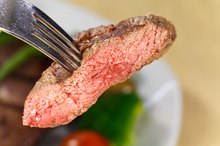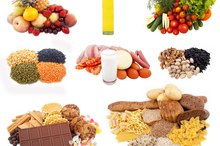How Is a Triglyceride Broken Down?
Introduction
Triglycerides, also known as triacylglycerols, are the basic units of fat storage in the body. They provide up to 40 percent of the daily requirement of energy in people living in industrial nations. Their ability to be compacted makes them the choice for energy storage in the body, where they are stored in fat cells (adipocytes) of white adipose tissue (WAT). Excess caloric intake is converted to triglycerides. Available carbohydrates only last about a day of fasting, while body fat, stored as triglycerides, can keep the body going for about a month. The liver, the heart and the resting muscles also utilize triglycerides for primary energy needs.
Triglyceride Breakdown
Triglycerides are made up of a spine of Glycerol and three fatty acid chains. When ingested in animal fats, they are broken down to these components in the intestinal lumen by the action of bile salts and pancreatic enzymes called pancreatic lipases. The components are absorbed and reassembled in the intestinal cells for distribution by lipoproteins, especially VLDL. Excess calories from other sources are also converted to fatty acids for storage as triglycerides, in lipid droplets mostly in fat cells, but also in tissues like the liver, heart and muscles.
Stored triglycerides are mobilized during fasting periods or between meals. The lipid droplets are broken down by tissue enzyme complexes called lipases. They are mostly inhibited by insulin and greatly stimulated by hormones like catecholamines (adrenaline) and, to a lesser extent, glucagon, thyroxine and cortisol. The drop in insulin levels during a fast or direct stimulation by hormones leads to the activation of these lipases, principally adipose triacylglycerol lipase (ATGL) and hormone sensitive lipase (HSL). These lead to the breakdown of triglycerides in a stepwise manner releasing a free fatty acid at each step, from a triglyceride to a diglyceride(by ATGL), then to a monoglyceride(by HSL) and finally to glycerol and a free fatty acid by monoacylglycerol lipase(MGL). The end products move out of the cell in different directions. The glycerol is taken to the liver for further breakdown or glucose synthesis. The free fatty acids are carried in the blood by albumin to cells that further break them down for energy by a process called beta oxidation. In the liver, the fatty acid by-products include ketones which the brain can use in times of fasting.
Medical Correlates
Insulin and Lipolysis
Learn More
Low blood sugar lowers insulin and removes the inhibition of triglyceride breakdown, leading to the mobilization of fat stores. This is the principle of the weight loss seen in fasting and diets with reduced free sugar. Exercise also puts a demand on the blood sugar and fatty acids leading to rapid breakdown of fat stores. Sickness and stress, through cortisol and adrenaline, speed up breakdown of fat stores as well.
Fish oils have recently been discovered to increase the utilization of fatty acids by beta oxidation, thus driving levels of triglycerides down. Fenofibrate, an antihypertriglyceridemic agent acts in much the same way in lowering blood triglyceride levels.
Related Articles
References
Writer Bio
IkechiK is an international medical graduate with U.S credentials and over 15 years of general medical practice experience in diverse cultural backgrounds. He has been delivering health education talks and writing health related content during that period for diverse audiences, from small group periodicals to informational websites. Based in Alexandria, IkechiK is pursuing further studies in Preventive Medicine.









